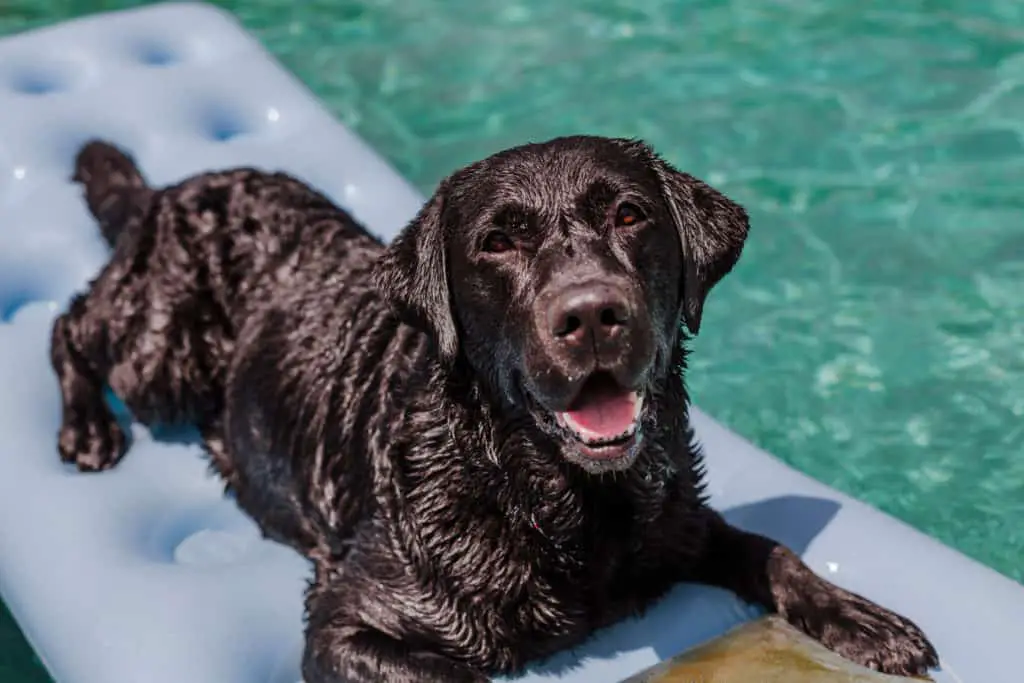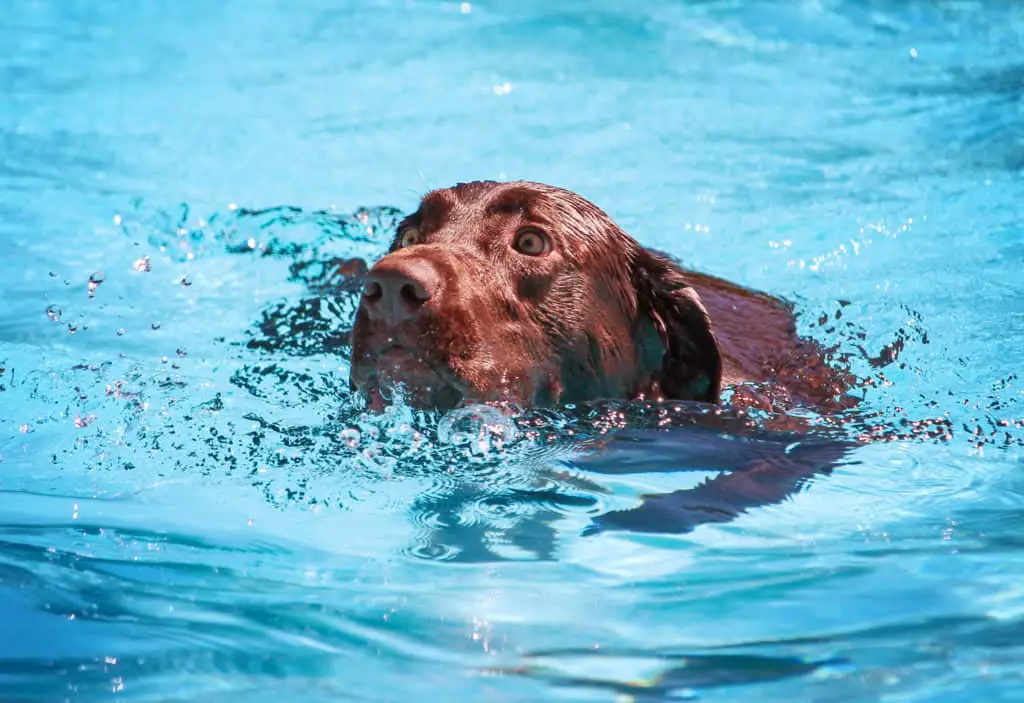This is a commonly asked question, so let’s address it upfront. The simple answer is yes, it’s safe for dogs to swim in backyard swimming pools. Many pool owners, especially those with breeds like Labradors and Golden Retrievers, find that their dogs thoroughly enjoy swimming without any major issues. It’s worth noting that smaller breeds can also swim, but they may need more attention from their owners as they might not be as proficient swimmers.
Swimming is a fun activity for many dogs, especially if you have a Labrador Retriever or any other member of the Retriever family. The love that these dogs have for water may encourage you to let them try out your pool.
But there are some things to think about before you let your furry friend jump in the pool with you. Several questions may arise in your mind, such as can dogs swim in a swimming pool? and are pools safe for dogs?
There are also other issues to consider such as pool maintenance. Do you have to clean the pool more often if your dog swims in it? Is the inevitable fur-shedding going to ruin your pool water? Or even worse, is your pool pump going to break because of the dog hair? Do not worry, because here are the answers to these important questions. Simply read on to know more.
Related post: Why Do Labrador Retrievers Love Water?

- Is It Safe for a Dog to Get into a Pool?
- Is Pool Water Bad for Dogs?
- How to Keep Dogs Safe in and Around Pools?
- How to Get Rid of Dog Hair from a Pool
- Can Dog Hair Ruin a Pool Pump?
- What Type of Pool is Best for Dogs?
- Do Dogs Like Kiddie Pools?
- What Are Dog Pools?
- Will a Dog Pop an Inflatable Pool?
- Is it Hygienic to Let Your Dog Swim in Your Pool?
- Let Your Dog Enjoy a Splash

Is It Safe for a Dog to Get into a Pool?
First of all, let us consider the safety aspects of letting your dog use your pool. If your dog is a natural swimmer, like a Retriever, you may not have to worry much about your dog getting into the pool. However, some dogs are not swimmers by birth and will need supervision when they are swimming. Other breeds like Labrador Retrievers are natural swimmers and feel perfectly comfortable in the water. However, there are some safety precautions to keep in mind regardless of the breed of your dog
Is Pool Water Bad for Dogs?
A point to consider here is that regardless of whether your dog is a good swimmer, the pool water must be maintained at all times so that it does not hurt your pet. Speaking of which, properly maintained chlorine levels in pool water won’t harm your dog in any way.
However, you have to keep in mind that if your dog drinks the pool water, it may have issues. As with humans, ingesting a lot of chlorinated water could cause gastrointestinal issues, skin problems, and in severe cases, intoxication and brain damage. Always keep the time in the pool short to avoid such issues and rinse the dog’s coat with normal water after the swim.

How to Keep Dogs Safe in and Around Pools?
Your dog must always be monitored when it swims or runs around the pool to prevent any unfortunate accident. But sometimes, if you are busy, it may not be possible to keep your dog away from the pool at all times. With certain safety protocols in place, however, you can be at peace and your dog can be safe in and around the pool. Here are some of the options you could try.
Pool Covers
A pool cover is not just a great way to keep the water clean when the pool is not in use but also comes in handy as a safety precaution. When choosing a pool cover, be sure to look for something of a sturdy material that does not give in under the weight of the dog.
It is best to go for covers that have heavy-duty straps that can be fixed to anchor brackets placed around the pool deck. Such covers are hard to lift. So, even if your dog is somewhere near the pool and you are not around, it can simply walk on the deck and cross the pool or even play on it happily without any fear of being drowned.
Pool Fence
Another way to keep your dog safe around the pool is to set up a pool fence. In some ways, a pool fence is even better than a pool cover as it does not allow the dog anywhere near the pool without your supervision.
Pool fences are also easier to install than pool covers and simply maintaining a latch gate is enough to allow or deny access. Ensure that your dog does not learn how to operate the latch gate, though.
You could also install both a pool cover and a pool fence for extra security. In case one fails the other will have your dog’s back.
Dog Pool Ladder or Ramp
Now that you know how to keep your dog safe around the pool, let us look at the safety measures you could take when the dog is about to use the pool. While humans can easily use the pool steps to go from shallow water to the deeper side of the pool, it does not work the same way with dogs.
Most dogs tend to fumble when navigating the steps while simultaneously handling the water all around. This is especially true for dogs who are new to swimming or pups. To address this challenge, it is best to invest in a good-quality dog pool ladder or a ramp. A ramp lets the dog walk into the water effortlessly and is best suited for dogs that are new to swimming.
For dogs that are comfortable with steps but find the human stairs too big to navigate, ladders specially made for dogs can help ease the discomfort. These ladders can generally be attached to stairs for humans so installing them is not a big deal.

How to Get Rid of Dog Hair from a Pool
Like it or not, if you let your dog use the pool, there is no getting away from the fact that there is going to be a lot of dog hair in the pool and dander inside the water. You could prevent some of it by brushing your dog’s coat before allowing it to jump into the water, but some fur is still going to enter the pool.
Regular cleaning of the pool water aside, you have to pay attention to the pool pump or filtration system because too much pet hair can block the pump.
Can Dog Hair Ruin a Pool Pump?
If maintained regularly, dog hair usually does not cause any lasting damage to the pool pump. Having said that, if hair continues to pile up over weeks and months, it might clog the filtration system and make the pool water murky. In severe cases, you may have to replace the entire filtration system, which could be costly.
To avoid such extensive damage, make sure you either use a pool sweep or a hand vacuum. You could also place an extra layer of mesh or filter (such as an old sock) if you do not have the time to clean the pump frequently.
What Type of Pool is Best for Dogs?
If you already have a pool set up, you may have no choice but to train your dog to try and swim in it. But some special pools may be more suitable for your dog. Let us look at which pools your dog may prefer.
Do Dogs Like Kiddie Pools?
Kiddie pools made of safe plastic are, in general, an excellent choice for dogs, especially for pups who are just learning how to swim. Kiddie pools also work great if your dog is of a smaller breed and is not a natural swimmer.
In a kiddie pool, the dog feels as if it is its very own safe space, a place to splash around and have fun. You can make the kiddie pool more interesting for your furball by throwing in some floatable toys or some ice during those peak summer afternoons.
If your dog is a bit bulkier, small-size pools may not be the best choice but you could get a slightly larger pool built of sturdier material to give your pet that personal space of water.

What Are Dog Pools?
If you have a spare kiddie pool lying around the house, by all means, use it for your dog. But there are also pools available in the market that are specifically designed for dogs. They are sturdier than an average kiddie pool and are also typically deeper with more room to play on and under the water.
Also, kiddie pools are designed keeping in mind that human babies do not shed fur or drool like your four-legged friend. If you have a dedicated dog pool, then its maintenance becomes easier and you do not have to fear when your child uses the same pool.
Dog pools are available in various sizes, so no matter how big your dog breed is, there is a pool for it available somewhere.
Will a Dog Pop an Inflatable Pool?
Inflatable pools may seem like the perfect choice if you and your dog go out on frequent trips. It is also good for those living in small homes where a permanent dog pool takes up a lot of space.
But with inflatable pools comes the danger of them being punctured by your dog easily. Even if you purchase the sturdiest inflatable pool out there, chances are your furry friend will pop it sooner or later. This is why inflatable pools are advisable only when you are on vacation and not for daily use.
Is it Hygienic to Let Your Dog Swim in Your Pool?
Let’s face it, no matter how much you groom your dog and brush its coat, it is never going to be as clean as a human. An average dog is usually three times dirtier than a human. They generally have fecal matter stuck to their hair and paws, which can make your pool unhygienic. Hence, you may need to use more chlorine in the water than usual.
Do Dogs Pee in Pools?
In general, they do not. The concept of peeing in dogs comes with marking their territory. As there is typically no territory to mark when a dog is in the pool, there is no need for it to pee. However, there may be exceptions if your dog is ill or nervous. Start with training if you do see your dog urinating in the pool. If it still does not work out, talk to your vet.
Let Your Dog Enjoy a Splash
Providing your pet dog with ample amounts of water space either in your backyard pool or in a dedicated dog pool is a surefire way to keep it happy and calm. If you manage to maintain your pool and keep it spick and span, nothing is keeping you from enjoying a cool splash in the pool with your furry friend.
Be sure to watch over it and keep it safe, though. With investments in safety tools, maintenance kits, and sturdy pool filters, you and your dog can have worry-free summers swimming in the cool blue water of your backyard pool.


